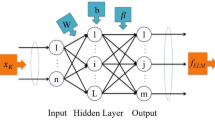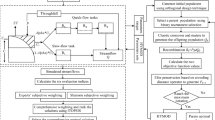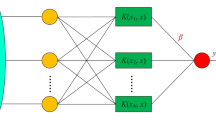Abstract
Deterministic flood prediction methods can only provide future point prediction results of the target variable. The intrinsic uncertainties and the fluctuation range of the prediction results cannot be evaluated. This study proposes a flood interval prediction method based on orthogonal chaotic non-dominated sorting genetic algorithm-II (OCNSGA-II) and kernel extreme learning machine (KELM) to estimate the uncertainty of the flood prediction results. The dual-output KELM model is exploited to predict the upper and lower bounds of the possible flood prediction result. The OCNSGA-II algorithm is employed to adjust the hidden layer output weights of the KELM model to minimize the prediction interval normalized average width (PINAW) and maximize the prediction interval coverage probability (PICP). The target variable with a disturbance of ±10% are taken as the initial upper and lower bounds. The superiority of the proposed method has been validated on one a real-world data set collected from the upper reaches of the Yangtze River in China. Results have shown that the proposed model can obtain prediction intervals with higher quality than the conventional single-objective interval prediction models and the other multi-objective benchmark models.





Similar content being viewed by others
References
Belayneh A, Adamowski J, Khalil B, Quilty J (2016) Coupling machine learning methods with wavelet transforms and the bootstrap and boosting ensemble approaches for drought prediction. Atmos Res 172:37–47
Beven K, Binley A (1992) The future of distributed models: model calibration and uncertainty prediction. Hydrol Process 6:279–298
Chen L, Ye L, Singh V, Asce F, Zhou J, Guo S (2014) Determination of input for artificial neural networks for flood forecasting using the copula entropy method. J Hydrol Eng 19:217–226
Efron B (1979) Bootstrap Methods: Another Look at the Jackknife 7:1–26
Fu W, Wang K, Li C, Tan J (2019a) Multi-step short-term wind speed forecasting approach based on multi-scale dominant ingredient chaotic analysis, improved hybrid GWO-SCA optimization and ELM. Energy Convers Manag 187:356–377
Fu W, Wang K, Zhou J, Xu Y, Tan J, Chen T (2019b) A hybrid approach for multi-step wind speed forecasting based on multi-scale dominant ingredient chaotic analysis, KELM and synchronous optimization strategy. Sustainability 11:1804
Hoerl AE, Kennard RW (1970) Ridge regression: biased estimation for nonorthogonal problems. Technometrics 42:80–86
Huang GB, Zhou H, Ding X, Zhang R (2012) Extreme learning machine for regression and multiclass classification. IEEE Transactions on Systems Man & Cybernetics Part B 42:513–529
Huang K, Ye L, Chen L et al (2018) Risk analysis of flood control reservoir operation considering multiple uncertainties. J Hydrol 565:672–684
Jin X, Xu CY, Zhang Q, Singh VP (2010) Parameter and modeling uncertainty simulated by GLUE and a formal Bayesian method for a conceptual hydrological model. J Hydrol 383:147–155
Khosravi A, Nahavandi S, Creighton D, Atiya AF (2010) Lower upper bound estimation method for construction of neural network-based prediction intervals. IEEE Trans Neural Netw 22:337–346
Khosravi A, Nahavandi S, Creighton D, Atiya AF (2011) Comprehensive review of neural network-based prediction intervals and new advances. IEEE Trans Neural Netw 22:1341–1356
Krzysztofowicz R (1999) Bayesian theory of probabilistic forecasting via deterministic hydrologic model. Water Resour Res 35:2739–2750
Kumar S, Tiwari MK, Chatterjee C, Mishra A (2015) Reservoir inflow forecasting using ensemble models based on neural networks, wavelet analysis and bootstrap method. Water Resour Manag 29:4863–4883
Li C, Wang W, Chen D (2019a) Multi-objective complementary scheduling of hydro-thermal-RE power system via a multi-objective hybrid grey wolf optimizer. Energy 171:241–255
Li W, Zhou J, Chen L et al (2019b) Upper and lower bound interval forecasting methodology based on ideal boundary and multiple linear regression models. Water Resour Manag 33:1203–1215
Li W, Zhou J, Sun H, Feng K, Zhang H, Tayyab M (2017) Impact of distribution type in Bayes probability flood forecasting. Water Resour Manag 31:1–17
Liu Z, Guo S, Shaokun HE, Huanhuan BA, Yin J (2018) Multivariate hydrologic uncertainty processor based on copula function. J Hydraul Eng 49:332–342
Peng T, Zhou J, Zhang C, Fu W (2017) Streamflow forecasting using empirical wavelet transform and artificial neural networks. Water 9:406
Peng T, Zhou J, Zhang C, Sun N (2018) Modeling and Combined Application of Orthogonal Chaotic NSGA-II and Improved TOPSIS to Optimize a Conceptual Hydrological Model. Water Resour Manag:1–19
Quan H, Srinivasan D, Khosravi A (2014) Particle swarm optimization for construction of neural network-based prediction intervals. Neurocomputing 127:172–180
Sun X, Wang Z, Hu J (2017) Prediction interval construction for byproduct gas flow forecasting using optimized twin extreme learning machine. Math Probl Eng
Wang WC, Kwokwing C, Xu DM, Chen XY (2015) Improving forecasting accuracy of annual runoff time series using ARIMA based on EEMD decomposition. Water Resour Manag 29:2655–2675
Xiong L, O’Connor KM (2008) An empirical method to improve the prediction limits of the GLUE methodology in rainfall–runoff modeling. J Hydrol 349:115–124
Xiong L, Wan M, Wei X, O'connor KM (2009) Indices for assessing the prediction bounds of hydrological models and application by generalised likelihood uncertainty estimation/indices pour évaluer les bornes de prévision de modèles hydrologiques et mise en œuvre pour Une estimation d'incertitude par vraisemblance généralisée. Hydrol Sci J 54:852–871
Yang X, Guan W, Liu Y, Xiao Y (2015) Prediction intervals forecasts of wind power based on PSO-KELM. Proc CSEE 35:146–153
Ye L, Zhou J, Gupta HV, Zhang H, Zeng X, Chen L (2016) Efficient estimation of flood forecast prediction intervals via single-and multi-objective versions of the LUBE method. Hydrol Process 30:2703–2716
Ye L, Zhou J, Zeng X, Guo J, Zhang X (2014) Multi-objective optimization for construction of prediction interval of hydrological models based on ensemble simulations. J Hydrol 519:925–933
Zhang C, Peng T, Li C, Fu W, Xia X, Xue X (2019) Multiobjective Optimization of a Fractional-Order PID Controller for Pumped Turbine Governing System Using an Improved NSGA-III Algorithm under Multiworking Conditions. Complexity
Zhang C, Wei H, Xie L, Shen Y, Zhang K (2016) Direct interval forecasting of wind speed using radial basis function neural networks in a multi-objective optimization framework. Neurocomputing 205:53–63
Zhang C, Zhou J, Li C, Fu W, Peng T (2017) A compound structure of ELM based on feature selection and parameter optimization using hybrid backtracking search algorithm for wind speed forecasting. Energy Convers Manag 143:360–376
Zhang H, Zhou J, Ye L, Zeng X, Chen Y (2015) Lower upper bound estimation method considering symmetry for construction of prediction intervals in flood forecasting. Water Resour Manag 29:5505–5519
Zhou J, Peng T, Zhang C, Sun N (2018) Data pre-analysis and Ensemble of Various Artificial Neural Networks for monthly Streamflow forecasting. Water 10:628
Zhou Q, Chen L, Singh VP, Zhou J, Chen X, Xiong L (2019) Rainfall-runoff simulation in karst dominated areas based on a coupled conceptual hydrological model. J Hydrol
Acknowledgements
This work is supported by the Natural Science Foundation of the Jiangsu Higher Education Institutions of China (No. 19KJB480007), the Natural Science Foundation of Jiangsu Province (No. BK20191052), the Natural Science Foundation of the Jiangsu Higher Education Institutions of China (No. 19KJB470012), the National Natural Science Foundation of China (NSFC) (No. 51709121, No. 51709122).
Author information
Authors and Affiliations
Corresponding author
Ethics declarations
Conflict of Interest
None.
Additional information
Publisher’s Note
Springer Nature remains neutral with regard to jurisdictional claims in published maps and institutional affiliations.
Rights and permissions
About this article
Cite this article
Peng, T., Zhang, C., Zhou, J. et al. Multi-Objective Optimization for Flood Interval Prediction Based on Orthogonal Chaotic NSGA-II and Kernel Extreme Learning Machine. Water Resour Manage 33, 4731–4748 (2019). https://doi.org/10.1007/s11269-019-02387-5
Received:
Accepted:
Published:
Issue Date:
DOI: https://doi.org/10.1007/s11269-019-02387-5




